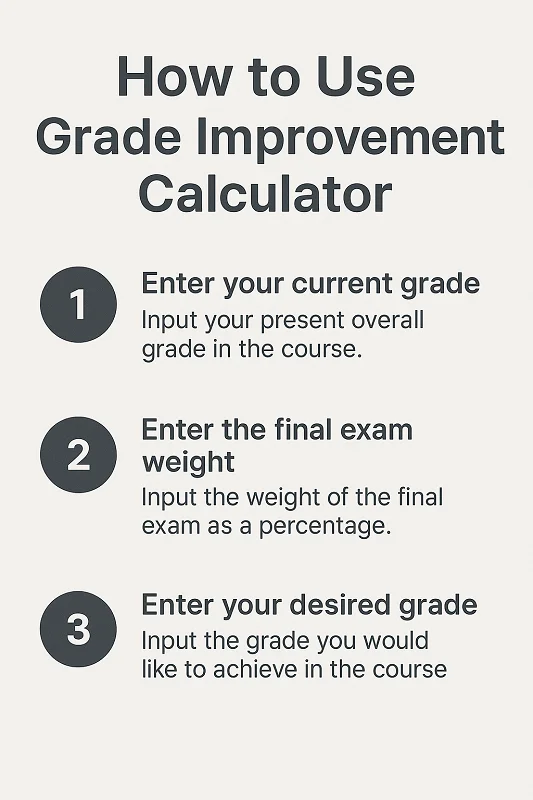Multiple Future Assignments (Optional)
Add multiple assignments with different weights for more detailed planning:
Calculate what you need to score on future assignments to reach your target grade
Add multiple assignments with different weights for more detailed planning:
Managing your academic performance can feel overwhelming, especially when you’re juggling multiple assignments, tests, and projects. That’s where a grade improvement calculator becomes your best friend. This powerful tool helps you understand exactly where you stand academically and shows you the path to achieving your target grades.
Whether you’re aiming for that A+ or simply trying to pass a challenging course, a grade improvement calculator takes the guesswork out of grade planning. It empowers you to make informed decisions about where to focus your study efforts and how much improvement you need on upcoming assignments.
A grade improvement calculator is a digital tool that helps students calculate their current grades and determine what scores they need on future assignments to reach their desired final grade. Think of it as your academic GPS – it shows you where you are now and the best route to get where you want to be.
The benefits of using a grade improvement calculator include:
Students across all levels – from high school to college – can use these calculators to take control of their academic journey and make data-driven decisions about their studies.
Understanding how grades work is the foundation of improvement. Most courses use a weighted grading system where different assignments contribute different percentages to your final grade.
Grade weighting means that some assignments count more toward your final grade than others. For example:
Follow these simple steps to calculate your current grade:
Example Calculation:
Current grade = (0.2125 + 0.18 + 0.132) ÷ 0.60 = 87.4%

Using a grade improvement calculator is straightforward and user-friendly. Here’s how to make the most of this valuable tool:
Inputting Your Information
Setting Target Grades
When setting your target grade, be realistic but ambitious. Consider:
Interpreting Results
The calculator will show you:
Most grade improvement calculators use color coding – green for achievable goals, yellow for challenging but possible, and red for requiring exceptional performance.
Strategies to Improve Your Grade
Once you know what grades you need, it’s time to create an action plan. Here are proven strategies to boost your academic performance:
Focus on High-Impact Assessments
Not all assignments are created equal. Prioritize your efforts based on:
Prioritize by Weight and Opportunity
Create a priority list using this approach:
Track Your Progress
Use your grade improvement calculator regularly to:
Update your calculator after each graded assignment to stay on track and make necessary adjustments to your study plan.
Let’s look at some real-world scenarios to see how grade improvement calculators work in practice:
Scenario 1: The Struggling Student
Sarah has a 72% in Biology and needs a 80% to maintain her scholarship. She has:
Calculator result: Sarah needs to score 95% on her final exam and 85% on her lab report to reach her target.
Scenario 2: The Ambitious Student
Mike has an 88% in History and wants to finish with an A (93%). He has:
Calculator result: Mike needs to score 100% on his research paper and 98% on his final exam – challenging but possible with dedicated effort.
Scenario 3: The Safety-Conscious Student
Lisa has a 85% in Mathematics and wants to ensure she doesn’t drop below 80%. She has:
Calculator result: Lisa only needs to score 65% on her remaining assignments to maintain her 80% target – giving her confidence and reducing stress.

Grade improvement calculators are highly accurate when you input correct information. The math is straightforward – it's the same calculation your teacher uses. However, accuracy depends on:
Most grade improvement calculators are designed specifically for weighted systems. Simply:
Grade improvement calculators work with various grading systems:
Most calculators allow you to select your preferred system or convert between them automatically.
Absolutely! You can use grade improvement calculators for all your courses. Many students find it helpful to:
Check these resources to find assignment weights:
A grade improvement calculator is more than just a mathematical tool – it’s your partner in academic success. By understanding your current standing, setting realistic goals, and creating strategic study plans, you can take control of your grades and achieve your academic objectives.
Remember that improvement takes time and consistent effort. Use your grade improvement calculator regularly to stay motivated, track progress, and adjust your strategies as needed. Whether you’re aiming for honor roll, trying to raise your GPA, or simply wanting to pass a challenging course, these tools provide the clarity and direction you need to succeed.
Don’t wait until it’s too late – start using a grade calculator today and watch your academic performance soar. Your future self will thank you for taking proactive steps toward better grades and a brighter academic future.